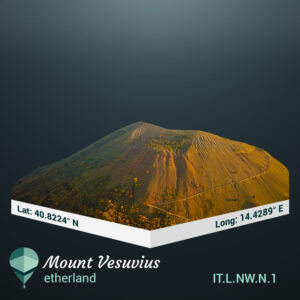 Rising up to 1281 meters, the Mount Vesuvius is one of the most famous, still active, stratovolcanoes. Known for destroying the old Roman city of Pompeii and many others in its catastrophic eruption of AD 79, it nowadays still threatens over 600,000 people living in its danger zone. Though we could think of it as a young volcano thanks to its high activity, the oldest rock found near the Vesuvius was estimated to be 300,000 years old.
Rising up to 1281 meters, the Mount Vesuvius is one of the most famous, still active, stratovolcanoes. Known for destroying the old Roman city of Pompeii and many others in its catastrophic eruption of AD 79, it nowadays still threatens over 600,000 people living in its danger zone. Though we could think of it as a young volcano thanks to its high activity, the oldest rock found near the Vesuvius was estimated to be 300,000 years old.
Mount Vesuvius is a somma-stratovolcano that is found overlooking the Gulf of Naples in southern Italy. It is a highly volatile volcano, one of the most dangerous volcanoes in Europe, partly because of its regular eruptions and location in a region where a major eruption could impact millions of people, particularly within the city of Naples. It has a prominent peak visible for miles around, and the summit stands 1,281 meters or over 4,200 feet above sea level. It was formed as a result of a collision of the African and Eurasian tectonic plates.
The name Vesuvius is derived from the Romans who believed the mountain was associated with Hercules, the Roman demi-god who was said to be the son of Zeus, the King of the Gods. According to tradition, Hercules had passed through this region at some point and had encountered a gang of bandits who were also giants. Here Hercules pacified these bandits with the aid of the gods, and this is most likely the reason why the Romans named one of the towns they settled here Herculaneum.
The volcano is most famous for its massive eruption of it in 79 AD. We have direct first-hand accounts of this from the Roman writer Pliny the Younger, who was present. From these and other archaeological works, historians and scientists have determined that in the late autumn of 79, the volcano erupted, spewing molten rock as high as 33 kilometers into the air. In the resulting eruption, the nearby towns of Pompeii and Herculaneum were completely covered in molten lava. As a result, the towns were preserved underneath the debris and today have been restored so that tourists can walk the streets of a Roman town from the Early Imperial Period.
Vesuvius has erupted many times since. An enormous eruption in 472 was said to have been so vast that ash deposits were identified as far away as the city of Constantinople (Istanbul) in the days that followed. Others eruptions came in quick succession, as when the volcano erupted in 968, 991, 999, and again in 1007, making it four eruptions in just under forty years. Today the volcano is closely monitored for signs of an eruption. A major one has not occurred since 1944 and it is understood that the strength of the eruptions intensifies the longer Vesuvius remains dormant.